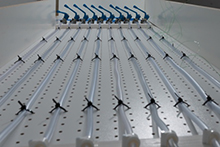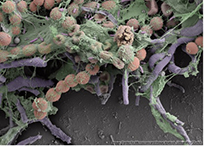Umweltmikrobiologie
Predicting and Managing Biofilms
Materials in contact with potable water variably influence the existing microbiome due to diverse surface properties and chemical compounds that are leaching into the water phase. Particularly, polymeric materials can release carbon compounds that add a considerable nutrient supply and therefore promote biofilm formation and growth. As biofilms influence both potable water quality as well as stability, it is important to generate a deeper insight on factors impacting their formation and growth.
The goal of this SNF-funded project is to properly characterize biofilms on materials in contact with potable water and to reveal the influence of key factors like material and water composition on their structure and community composition. With this knowledge we attempt to engineer desirable biofilm communities on specific materials.
The Ugly Duckling-Project
Bathtub toys pose a promising link between (1) potable water, (2) plastic materials, (3) external contamination and (4) vulnerable end-users. While social media is rife with communication about unwanted microbial growth in such toys, scientific information is limited. Therefore, biofilms on the inner surface of several toys, used under either real or controlled conditions, have been characterised by optical coherence tomography, flow cytometry, electron microscopy, conventional plating for indicator bacteria and 16S/18S illumina sequencing analysis.


